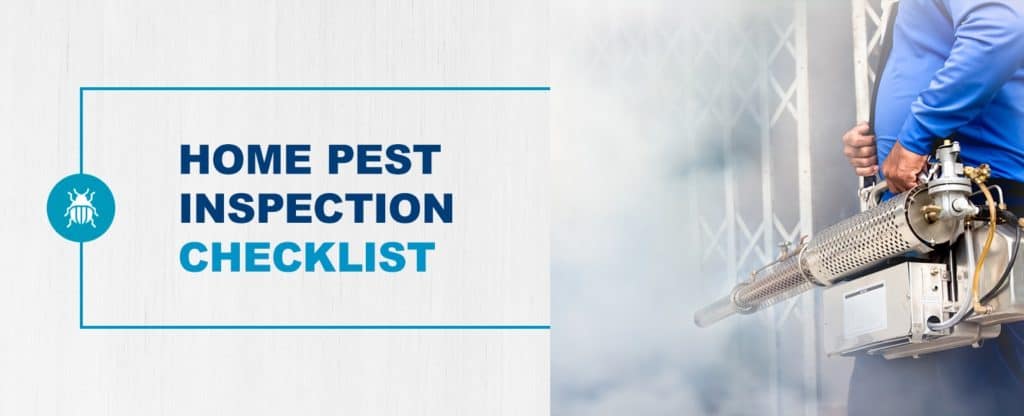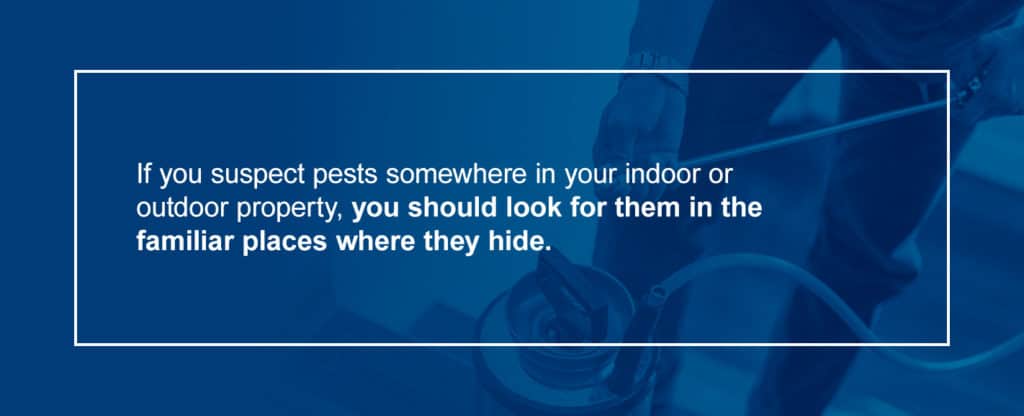Home Pest Inspection Checklist

Your home comes with the possibility of rodents, insects and other wildlife visiting you. These critters tend to sneak in through holes in the attic, windows and doors, and they could damage your indoor and outdoor living space.
Regular cleaning and inspecting of your property should help prevent pests from coming into your home.
Use this home pest inspection checklist seasonally to check for pest activity and ensure your property is secure.
Table of Contents
click to explore content
- Physical Evidence of Pest Activity
- Checking Your Home for Pest Activity
- Pest Prevention: Making Sure Your Home Is Secure
Physical Evidence of Pest Activity
Here are some of the signs that you have pests in your house or backyard:
- Visible bugs or rodents: Check for dead pests or body parts throughout the home, including in any sticky traps you might have set.
- Pest droppings: Look around for droppings or a trail of urine on the floor or near food. The fecal matter from rodents might be easy to see, but if you look hard enough, you could also find small droppings from bugs.
- Chew marks: Inspect food containers and fabrics from furniture for bite marks from rodents. Outside of the home, you may notice little holes in your plants from insects.
- Termite tunnels: Inspect your attic and places with moisture for termite tunnels, which are about the size of a pencil.
- Evidence of nesting: Check for nests, such as piles of debris, insulation or dust in quiet areas. Rodents will usually set up camp in paper, rags, straw or cardboard.
- Greasy rub marks: Inspect your kitchen countertops and cabinets for oily residue left behind from rodents.
- Unpleasant noises: Listen for gnawing, squeaking or movement sounds throughout the house, especially in ceilings, pantries and walls.
- Musty odors: A cockroach infestation could produce a potent smell and cause allergy symptoms.
Checking Your Home for Pest Activity

If you suspect pests somewhere in your indoor or outdoor property, you should look for them in the familiar places where they hide.
But where might that be? Below, we outline common places that pests or pest activity happens.
Look in these places to find out if you have pest activity in your living space:
Outside of the House
Check the following places throughout the outside of your property for pest activity:
- The roof: Take your binoculars and inspect the perimeter of your property. Check for animal nests in the vents and missing or broken shingles on the roof’s surface.
- Outdoor plants: Insects can hide in plants both inside and outside of your house. Trim your plants regularly and inspect them for bugs.
- Window screens: Rodents or insects could rip through window screens and find their way into your living space. Check all your windows for holes.
- Vent covers: If there are missing vents in your roof or central air system, a rodent could wander into your house.
- Clothes: If you’ve spent extensive time outside, check yourself for ticks and mosquitoes before entering your house.
- Deliveries: Check your packages or boxes for pests before carrying them into your home.
Attic
Take a trip upstairs and look for evidence of pest activity near these components:
- Holes in the walls: Rodents could climb in the drywall gaps and eat through your electrical wires and insulation.
- Storage bins: Cockroaches and rodents enjoy clutter because it gives them a place to hide. Check your storage bins for holes or removed lids.
- Utility lines: Inspect the wires for your electricity, hot water and other utilities for chew marks. Seal the gaps around the cords with steel wool and caulk.
Kitchen
The kitchen attracts pests because of its abundance of food and water. Pay careful attention to these areas:
- Behind the refrigerator: Cockroaches and crickets could hide under your kitchen appliances in search of food. Pull the fridge away from the wall and check under and behind it.
- Cabinets: Look inside, under and behind cabinets for crumbs or other signs of pest activity.
- Toe kicks: If you have a baseboard under your floor cabinets, bits of food tend to get stuck there. Check the toe kick for bugs or droppings.
- Pantry: Go through your food supply and make sure you don’t have any items with holes or tears in the packaging.
- Interior trash cans: Check your trash cans and receptacles for crawling bugs.
- Sinks: Ants looking for a good meal can find their way to your kitchen, especially if you have food stuck in the drain or dirty dishes taking up space.
Bathroom
The bathroom is also a popular spot for pests that are attracted to moisture. Check behind and inside of these parts:
- Sinks and drains: All types of pests are attracted to moisture, and certain insects enjoy eating shampoos and other beauty products.
- Shower stalls: Check the grout around bathtubs and toilets for signs that pests ate through it.
- Tub floors: Insects are attracted to the moisture in your tub floors. Check your tub floors regularly and remove excess moisture at the end of the day.
Bedrooms and Living Room
Inspect every corner of the rooms where you relax in the house, paying attention to the following features:
- Ceilings: Spiders often make webs in the corners of rooms, in a place that’s out of reach. Take a broom and sweep any cobwebs you find.
- Furniture: Check your mattress and any upholstered furniture for bed bugs, carpet beetles or fleas, especially if you have overnight guests or go on vacation.
- Stacks of paper: Cockroaches tend to snack on pieces of paper and hide in cluttered piles.
- Baseboards: Bugs and rodents hide in baseboard heaters to keep warm and travel from one room to the other.
- Floors: Check your carpeting and hardwood panels for signs of insect or rodent damage, such as droppings or scratches.
- Closets: Take a flashlight and look for moths, silverfish, carpet beetles, mice, spiders or crickets on your valuables. You should also check seasonal clothes before wearing them.
- Cracks in the wall: Spiders can make webs in crevices around the windows or the wall. Check for gaps around your doors and windows and fill them immediately.
- Window screens and trim: Check for insect body parts, such as dead skin or wings, on your window sills.
Basement or Crawlspace
Take a flashlight and inspect your crawlspace or basement for signs of rodents, ants or cockroaches, especially in these areas:
- Near the fuse box: Rodents can chew through wires and damage the electricity in your property. Inspect your electric box for spliced wiring and faulty electric currents.
- Around the tank water heater: Check under and around your tank water heater for termites that enjoy excess moisture and wet wood.
- Behind the washer and dryer: Rodents and insects enjoy the humidity and heat from behind your laundry units.
- In utility lines: Check for gaps in utility lines and vents, and use steel wool and caulk to seal holes with cords going through them.
Garage
Check the garage for pest activity in the following components:
- Car: All types of pests could make their way into your vehicle’s gaps, including under the hood. Get it inspected to make sure that pests haven’t damaged it in any way.
- Garbage cans: Check your outdoor garbage cans for insects. You would also know if there are raccoons in the area if your garbage can gets knocked over in the middle of the night.
- Recycle bins: If you put food items in your recycle containers, you should also check them for raccoons and insects.
- Cardboard boxes: Insects, especially cockroaches, like to hide in cardboard boxes. If you store recycled material in your garage, check it often to ensure there are no bugs inside.
- Grill: Check your outdoor cookware for cobwebs and other signs of insects.
Pest Prevention: Making Sure Your Home Is Secure
Although some pests aren’t totally preventable, there are some things that you can do to reduce the likelihood of a pest problem.
Here’s are some prevention techniques for keeping pests out of your home:
- Reduce Standing Water
- Maintain Your Plants
- Repair Home Damage
- Take Care of Food and Waste
- Deep Clean Your Home
Reduce Standing Water
Mosquitoes and other insects are drawn to standing water, so you can follow these tips to limit their activity by getting rid of the water around your property:
- Inspect ceilings and around the windows: Look for signs of water damage, such as discoloration or mold.
- Check your irrigation system: Make sure water drains away from your property and that there are no wet areas around the house that could attract mosquitoes.
- Listen to the water heater: If the flow within the heater makes a popping, gurgling or snapping noise, there might be sediment inside that could clog the unit.
- Think about the quality of your HVAC: Your air conditioning gets rid of humidity in the air, but if it’s old, it might not be sufficient. Consider replacing it to get rid of the excess moisture.
- Ventilate crawlspaces: Make sure your attic, basement or crawlspace is well ventilated and dry with fans and dehumidifiers. Maintain a 40% humidity level in the basement.
- Repair your roof’s flashing: Inspect and replace the flashing on your roof to prevent water damage to your house’s wooden parts.
- Dump standing water from buckets and pools: Get rid of or limit places where mosquitoes could breed around your property, such as buckets, kiddie pools, wheelbarrows and planters.
Maintain Your Plants
Trees and shrubbery that brush against the house could provide an entryway for bugs into your property. Follow these tips for trimming your plants and keeping away pests:
- Limit your use of mulch: Check for mulch or pine needles that could attract insects to your garden. Use rubber mulch or rocks instead of laying mulch near the foundation of your house.
- Trim shrubbery: Cut the tree branches or shrubs that brush against the siding of your home.
- Protect your outdoor plants with wire: Wrap a wire cloche around your plants to keep rodents from munching on them.
- Put bird feeders away from the house: Set up bird feeders at the opposite end of your yard to keep animals away from the house.
- Use sterile soil indoors: Pot your plants in soil without living bacteria in it to prevent insect larvae from coming into your property.
- Dust your indoor houseplants: Clean your houseplants with a moist rag and soapy water to get rid of dust buildup.
- Grow insect-repelling plants: Citronella, horsemint, marigolds, ageratum and catnip are known to repel mosquitoes.
- Mow the lawn frequently: Keep your grass short so rodents and insects can’t hide.
Fill in the Gaps and Repair Damage
Rodents can sneak into small gaps in your house. Limit pests’ access to your interior living space with these techniques:
- Repair your foundation: Seal foundation cracks with a vinyl concrete patch to prevent insects and mice from sneaking in through your basement or crawl space.
- Check for wood rot: Inspect the joists in your attic and the siding around your house for wooden wet or dry rot. Replace any pieces of wood that have deteriorated so they don’t attract termites.
- Repair the dryer vent outside: Check the dryer vent to ensure that the damper is intact and functional so rodents can’t crawl in through the house.
- Seal window screens: Inspect and repair window screens and keep your windows closed at night to keep out mosquitoes.
- Seal openings around the door: Check the trim around your door for cracks or holes, and seal it with caulk. Put a door sweep under the door to prevent insects from traveling through the opening.
- Fill in gaps near pipes: Repair cracks and holes in the floors and walls around piping.
- Repair cracks in the roof: Apply sealant around the cracks on the top of your house to prevent insects, squirrels, bats and mice from crawling into your attic.
- Fix the gaps in your siding: Fill holes in your siding to prevent termites from crawling inside.
- Cover your chimney: Cover the top of your chimney with a cap or a fine wire mesh.
Take Care of Food and Waste
Here are some ways to limit pests’ food sources around your house:
- Seal your food: Put lids on all of your food containers, and store food in sealed plastic or glass.
- Put food on shelves: Instead of storing food on the floor, put it in a closed cabinet.
- Store pet food: Keep pet food in a closed container, and avoid leaving out pet food and water overnight.
- Clean up food immediately: Get rid of food wrappers and crumbs throughout the house, and clean up spilled food right away. If you notice you have food stains somewhere inside or outside of your property, clean them immediately.
- Get rid of outdoor debris: Clear away piles of tree branches and leaves that could accumulate moisture and welcome termites onto your property.
- Clean outside garbage cans: Cover outside garbage containers with a lid, and rinse them regularly to remove food residue.
- Throw out your garbage daily: If you have multiple trash receptacles in various rooms, empty them into a sealed garbage can every day to get rid of food wrappers and other trash.
- Rinse recyclables: Before you put them outside, rinse your recyclables to keep pests away from your recycle bin.
Deep Cleaning Your House to Manage Pests
If you keep your house clean, you’ll notice pests before they become a problem. Here are some tips for cleaning out the house:
- Clean out the gutters: After a storm and once every season, clear your gutters from blockage or obstructions.
- Wash the dishes: Wash your dirty dishes before going to bed at night.
- Clean the kitchen sink: Rinse out the drain with vinegar and baking soda.
- Wipe down hard-to-reach areas: Deep clean hard-to-reach areas to prevent buildup.
- Declutter each room: Get rid of stacks of newspapers, cardboard or other clutter where pests can hide.
- Deep clean the whole house: Deep clean your home at least once a season, paying attention to every corner of the house.
- Sweep the basement: Sweep cobwebs often to prevent spiders from making a home on your property, especially in your basement.
- Clean the floors: Regularly sweep, vacuum and mop your floors to disturb any areas where pests might be considering making a home.
- Clean the refrigerator: Wipe down the surfaces inside and outside your fridge and throw away old food.
- Clean or replace the air filter: Keep air conditioning filters clean to prevent moisture accumulation that could attract pests.
Contact Pestech to Schedule Your Inspection in New York
At Pestech, we offer residential pest management services that are safe for the whole family and effective at controlling rodents, insects and wildlife. If you live in New York and you’d like a professional inspection, contact us online and we’ll set up an appointment with you.

